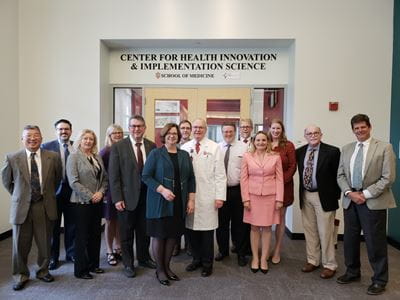A computer is as ubiquitous in the doctor’s office today as a blood pressure cuff.
Despite that, many of today’s medical students are inadequately trained in the use of electronic health records (EHR) – posing major concerns in a profession that increasingly relies on technology and data to guide decisions and ensure patient safety. With the support of the American Medical Association, Indiana University School of Medicine and Regenstrief Institute have created a teaching tool and curriculum that will change how medical and health professions students across the country learn to use electronic health records.
“Given that today’s physicians are spending more than 50 percent of their time working in electronic health records, it’s hard to comprehend why medical students often don’t have the opportunity to learn how to log into an EHR and manage patients in that setting,” said Susan E. Skochelak, MD, MPH, American Medical Association group vice president for medical education. “We wouldn’t let physicians graduate without knowing how to use a stethoscope, yet our future physicians are graduating without proper understanding and hands-on experience using this core tool that they’ll need in practice every day.”
Developing a First-of-its-Kind Tool and Curriculum
In 2013, the American Medical Association awarded IU School of Medicine a $1 million grant to partner with the Regenstrief Institute to develop an EHR teaching tool and curriculum. This tool, the Regenstrief Electronic Health Record Clinical Learning Platform (RECLP) and the corresponding curriculum teach future physicians and health care providers how to use electronic health records to improve patient care. IU School of Medicine also became a member of the American Medical Association’s Accelerating Change in Medical Education Consortium. RECLP is now being used by 15 other medical schools and health professional training programs around the country—and the goal is to make it available to learners at many more institutions.
“[The teaching electronic health record tool developed by IU School of Medicine and Regenstrief] is really the first of its kind,” Skochelak said. “This is a tool that doesn’t just teach our future physicians and health professionals how to use an EHR. It also shows them how to use this tool to make their practice better and improve patient outcomes. The American Medical Association is very excited to continue our ongoing partnership with IU and Regenstrief to further enhance the teaching EHR tool and develop a national curriculum that can be widely disseminated to medical and health professions schools throughout the country—it’s something everybody needs.”
Marking a milestone in the five-year grant, Skochelak and other American Medical Association leaders visited the IU School of Medicine campus last week to learn from IU and Regenstrief faculty and staff how the tool and curriculum have advanced. During the visit, the group discussed how to ensure the tool continues to reach more institutions moving forward. Bradley Allen, MD, PhD, one of the project’s principal investigators, talked about the advancements and momentum that have already been achieved.
“If used correctly, an electronic health record can be more than a place to record vital signs and test results; it can help physicians provide high-quality care more effectively,” Allen said. “For instance, electronic health records can help detect potential drug interactions, alert providers to the need for upcoming screenings, and assist the coordination of patient care among a variety of health care providers. In order for these benefits to be achieved, health care providers need proper training in how to use electronic health records. Our work with RECLP is improving and bringing that training to more health professions students across the country.”
Next Steps
In an era where medical care is rapidly changing, this tool prepares current students to seamlessly integrate into modern health care settings. Continuing to make strides like these will improve interprofessional collaboration and patient care in a profound way.
“In Indiana, there are more than 8,000 health professions students,” Skochelak said. “What this tool could allow them to do is actually work together in a virtual environment. We haven’t figured out a way to get 8,000 students in a classroom. But the fact that they can collaborate through this tool in a very practical way sets the culture and the stage for how we already practice and could practice even better in the future.”
Blaine Takesue, MD, assistant professor of clinical medicine at IU School of Medicine and a core leader in the project from Regenstrief Institute, is excited about the project’s future.
“Like any good idea, this project moves in directions we could not have imagined at the start. We are extremely pleased other medical school and health professions schools find this tool helpful. We are very fortunate IU School of Medicine wants to become a “laboratory” to study how health information technology should be taught to health professionals. With the support of IU School of Medicine and the American Medical Association we have parallel project trajectories. The first pathway is to continue to help new providers understand how to use an electronic health record. A second pathway is to help learners understand basic data analytic and population health principles. A third pathway is to help develop a health information technology curriculum for the continuum of medical training, from medical school through practicing careers.”
As the initial grant period comes to a close, IU School of Medicine and the Regenstrief Institute have committed to continue working with the American Medical Association’s Accelerating Change in Medical Education Consortium. The American Medical Association will soon announce the next phase of the consortium and curriculum projects, which will include further development and rollout of the EHR tool and curriculum, with the ultimate goal of transforming medical education nationwide
